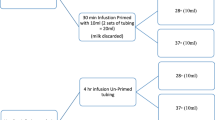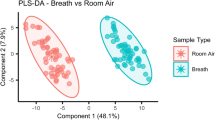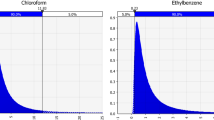Abstract
Objective:
To determine emission of volatile organic compounds (VOCs) from plastic medical equipment within an incubator.
Study Design:
Air samples from incubators before and after adding medical equipment were analyzed using EPA TO-15 methodology. Headspace analysis was used to identify VOC emissions from each medical equipment item. Air changes per hour (ACH) of each incubator were determined and used to calculate the emission rate of identified VOCs.
Results:
Cyclohexanone was identified in all incubator air samples. At 28 °C, the mean concentration before and after adding medical equipment items was 2.1±0.6 and 57.2±14.9 μg m−3,respectively (P<0.01). Concentrations increased to a mean of 83.8±23.8 μg m–3 (P<0.01) at 37 oC and 93.0±45.1 μg m–3 (P=0.39) after adding 50% humidity. Intravenous tubing contributed 89% of cyclohexanone emissions. ACH were determined with access doors closed and open with means of 11.5±1.7 and 44.1±6.7 h–1, respectively. Cyclohexanone emission rate increased from a mean of 102.2 μg h–1 at 28 oC to 148.8 μg h–1 (P<0.01) at 37 oC.
Conclusion:
Cyclohexanone was quantified in all incubator air samples containing plastic medical equipment. The concentration of cyclohexanone within the incubator was inversely related to ACH in the closed mode. The cyclohexanone concentration as well as the emission rate increased with higher temperature.
This is a preview of subscription content, access via your institution
Access options
Subscribe to this journal
Receive 12 print issues and online access
$259.00 per year
only $21.58 per issue
Buy this article
- Purchase on Springer Link
- Instant access to full article PDF
Prices may be subject to local taxes which are calculated during checkout

Similar content being viewed by others
References
Rumchev K, Brown H, Spickett J . Volatile organic compounds: do they present a risk to our health? Rev Environ Health 2007; 22 (1): 39–55.
Xiang Q, Mitra S, Xanthos M, Dey SK . Evolution and kinetics of volatile organic compounds generated during low-temperature polymer degradation. J Air Waste Manag Assoc 2002; 52 (1): 95–103.
Pinkerton KE, Joad JP . Influence of air pollution on respiratory health during perinatal development. Clin Exp Pharmacol Physiol 2006; 33 (3): 269–272.
Lacasana M, Esplugues A, Ballester F . Exposure to ambient air pollution and prenatal and early childhood health effects. Eur J Epidemiol 2005; 20 (2): 183–199.
Wogan GN, Hecht SS, Felton JS, Conney AH, Loeb LA . Environmental and chemical carcinogenesis. Semin Cancer Biol 2004; 14 (6): 473–486.
Boeglin ML, Wessels D, Henshel D . An investigation of the relationship between air emissions of volatile organic compounds and the incidence of cancer in Indiana counties. Environ Res 2006; 100 (2): 242–254.
Wang L, Pinkerton KE . Air pollutant effects on fetal and early postnatal development. Birth Defects Res C Embryo Today 2007; 81 (3): 144–154.
Weisel CP . Assessing exposure to air toxics relative to asthma. Environ Health Perspect 2002; 110 (Suppl 4): 527–537.
Prazad P, Cortes DR, Puppala BL, Donovan R, Gulati A . Airborne concentrations of volatile organic compounds in neonatal incubators. JPerinatol 2008; 28 (8): 534–540.
Eppler M, Donovan R, Schweig L, Cortes DR, Prazad P, Gulati A et al. Effect of phototherapy on airborne concentrations of volatile organic compounds found in neonatal incubators. JNPM 2012; 5 (3) 221–227.
Salthammer T, Fuhrmann F, Uhde E . Flame retardants in the indoor environment – part II: release of VOCs (triethylphosphate and halogenated degradation products) from polyurethane. Indoor Air 2003; 13 (1): 49–52.
ASTM D5116–10 ASTM D5116–10 Standard Guide for Small-scale Environmental Chamber Determinations of Organic Emissions from Indoor Materials/Products. ASTM International: West Conshohocken, PA, 2010.
ASTM E741-00 ASTM E741-00 Standard Test Method for Determining Air Change in a Single Zone by Means of a Tracer Gas Dilution. ASTM International: West Conshohocken, PA.
Martis L, Tolhurst T, Koeferl MT, Miller TR, Darby TD . Disposition kinetics of cyclohexanone in beagle dogs. Toxicol Appl Pharmacol 1980; 55 (3): 545–553.
Greener Y, Youkilis E . Assessment of the cataractogenic potential of cyclohexanone in guinea pigs and rabbits. Fundam Appl Toxicol 1984; 4 (6): 1055–1066.
Social Europe. Recommendation from the scientific expert group on occupational exposure limits for cyclohexanone. SEG/SUM/17 1992.
World Health Organization. International Agency for Research on Cancer monographs on the evaluation of carcinogenic risks to humans. 1999; 71: 1359–1364.
Gupta PK, Lawrence WH, Turner JE, Autian J . Toxicological aspects of cyclohexanone. Toxicol Appl Pharmacol 1979; 49 (3): 525–533.
The MAK Collection for Occupational Health and Safety. Cyclohexanone. BAT Value Documentation 2010; 5: 157–163.
Ong CN, Sia GL, Chia SE, Phoon WH, Tan KT . Determination of cyclohexanol in urine and its use in environmental monitoring of cyclohexanone exposure. J Anal Toxicol 1991; 15 (1): 13–16.
Falk O, Jacobsson S . Determination of cyclohexanone in aqueous solutions stored in PVC bags by isotope dilution gas chromatography-mass spectrometry. J Pharm Biomed Anal 1989; 7 (10): 1217–1220.
Story DA, Leeder J, Cullis P, Bellomo R . Biologically active contaminants of intravenous saline in PVC packaging: Australasian, European, and North American samples. Anaesth Intensive Care 2005; 33 (1): 78–81.
Danielson JW . Capillary gas chromatographic determination of cyclohexanone and 2-ethyl-1-hexanol leached from solution administration sets. J Assoc Off Anal Chem 1991; 74 (3): 476–478.
Ulsaker GA, Korsnes RM . Determination of cyclohexanone in intravenous solutions stored in PVC bags by gas chromatography. Analyst 1977; 102 (1220): 882–883.
Snell RP . Capillary GC analysis of compounds leached into parenteral solutions packaged in plastic bags. J Chromatogr Sci 1989; 27 (9): 524–528.
Mills G, Walker V . Urinary excretion of cyclohexanediol, a metabolite of the solvent cyclohexanone, by infants in a special care unit. Clin Chem 1990; 36 (6): 870–874.
Thompson-Torgerson CS, Champion HC, Santhanam L, Harris ZL, Shoukas AA . Cyclohexanone contamination from extracorporeal circuits impairs cardiovascular function. Am J Physiol Heart Circ Physiol 2009; 296 (6): 1926–1932.
National Institute for Occupational Safety and Health. Division of standards development and technology transfer. Occupational Safety and Health Guideline for Cyclohexanone 1988.
The American Institute of Architects and The Facilities Guidelines Institute The American Institute of Architects and The Facilities Guidelines Institute Guidelines for Design and Construction of Hospital and Health Care facilities. American Institute of Architects Press: Washington, DC, 2001.
Khoudja RY, Xu Y, Li T, Zhou C . Better IVF outcomes following improvements in laboratory air quality. J Assist Reprod Genet2013. 30 (1): 69–76.
Acknowledgements
This research was funded by a grant from the Advocate Lutheran General Health Partners Endowment.
Author information
Authors and Affiliations
Corresponding author
Ethics declarations
Competing interests
The authors declare no conflict of interest.
Rights and permissions
About this article
Cite this article
Colareta Ugarte, U., Prazad, P., Puppala, B. et al. Emission of volatile organic compounds from medical equipment inside neonatal incubators. J Perinatol 34, 624–628 (2014). https://doi.org/10.1038/jp.2014.65
Received:
Revised:
Accepted:
Published:
Issue Date:
DOI: https://doi.org/10.1038/jp.2014.65
This article is cited by
-
Dynamic Headspace GC–MS Method to Detect Volatile Extractables from Medical Device Materials
Biomedical Materials & Devices (2024)
-
Migration of cyclohexanone and 3,3,5-trimethylcyclohexanone from a neonatal enteral feeding system into human milk
Journal of Perinatology (2021)
-
Urinary metabolites of volatile organic compounds of infants in the neonatal intensive care unit
Pediatric Research (2018)



